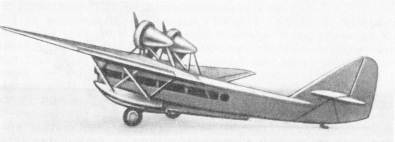| Technical data | ||
|---|---|---|
| Type | Sh-5 | |
| Function | Land based aerial cartography | Amphibian aerial cartography |
| Year | 1934 | 1934 |
| Crew | 2 | 2 |
| Engines | 2*480hp M-22 | |
| Length | 15.0m | 15.0m |
| Wingspan | 24.0m | 24.0m |
| Wing area | 73.1m2 | 73.1m2 |
| Empty weight | 3150kg | 3470kg |
| Loaded weight | 5000kg | 5000kg |
| Wing Load (kg/m2) | 68.5 | 68.5 |
| Power load (kg/hp) | 5.2 | 5.2 |
| Speed at 0m | 225km/h | 213km/h |
| Landing Speed | 80km/h | 80km/h |
| Landing Roll | 240m 16sec | 240m 16sec |
| Takeoff Roll | 220m 13sec | 250m 16sec |
| Range | 1200km | 800km |
| Flight Endurance | 8.0hmin | 5.0hmin |
| Ceiling | 5400m | 4900m |
| Climb | ||
| 1000m | 4min | 5min |
| 2000m | 8min | 10min |
| 3000m | 13min | 16min |
| 4000m | 22min | 30min |
| Payload | ||
| Fuel+oil | 800kg | 500kg |
| Seats | 12 seats or 8 stretchers | |
| Cargo | 1050kg | 1030kg |
Sh-5, FS-1, FS-2 by V.B.Shavrov and K.A.Vigand, TsKB
 |
In 1928 wide program of the USSR territory mapping started. Aviation supposed to play large role in this program, providing aerial photography and support of ground groups. No special aircraft for aerial photography existed, variety of available platforms were not well suited for the goal. Camera view was often restricted by cockpit location, obscured by wing struts, wires or landing gear. Conditions for camera operator in tight cockpits of military (or converted) planes like R-5 were far from appropriate for mapping photography.
In early 1929 special task force was established. It accepted V.B.Shavrov's offer of a cartography amphibian, because the wast areas of the USSR had no suitable airfields except rivers and lakes.
In Spring 1930 requirements to the cartography aircraft were formulated. In June projects for amphibian and similar land based aircraft were ready (design by V.B.Shavrov, calculations by K.A.Vigand)1. Aircraft were designated FS-1 and FS-2.
Originally project was assigned to Richard's KB, in March 1931 - transferred to TsKB back under V.B.Shavrov's supervision. At that time FS-1 and FS-2 project were joined into single Sh-5 design. It was an amphibian with detachable floats.
Assembly was performed at ZOK NII GVF, plant with very limited capacities. Sh-5 was of mixed design. Fuselage had steel frame with fabric skin. Floats - wooden, covered with fabric with sealant. Wing and tailfin - duralumin with fabric. Landing gear and floats struts - steel tubes with duralumin fairings.
During construction aircraft was made multi-functional. 12 removable passenger seats were installed. Sh-5 could be converted into ambulance with 8 stretchers and medical personal. Large door and roof hatch allowed to use it as a cargo transport when seats/stretchers are removed. Enclosed pilot's cabin was located in the nose, providing adequate view for aerial cartography.
Trials started on March 19,1934on skis, interrupted at the end of year when landing gear collapsed (manufacturing defect was blamed). Trials continued after repairs on January 5 1935.
Despite overall performance was in compliance with requirements, aircraft was abandoned. 5-years old design and layout became more and more obsolete, with little upgrade opportunities.
Aerial cartography niche was occupied at the time by sturdy reliable R-6.
 |
 |
 |
 |
 |
| Predecessors | Modifications |
|---|---|
| Aircraft was unique in its concept and had no successors. | |
| References | Links |
|---|---|
|
|
|